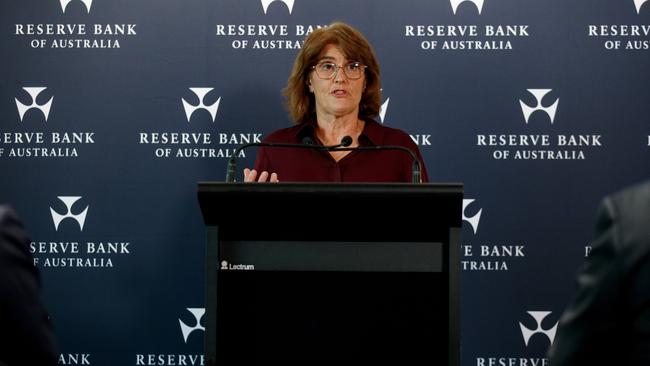CBA, Westpac still expect RBA to cut interest rates this year but it’s finely balanced
A November interest rate cut is still on the cards according to CBA and Westpac economists as the central bank seeks to protect employment gains as much as possible.

An interest rate cut by the Reserve Bank in November is still on the cards, according to CBA and Westpac economists, as government subsidies will help cap price increases and the central bank seeks to protect employment gains as much as possible.
After higher than expected inflation data in recent months, the consensus among market economists has shifted, with the majority now expecting the RBA to keep its cash rate target on hold at 4.35 per cent, before announcing an initial cut of 25 basis points in the March quarter.
However, a growing number of economists expects the RBA board will be forced to lift the cash rate to a more than 12-year high of 4.6 per cent in August if the nation’s core “trimmed mean” inflation rate remains at 4 per cent or rises in June quarter data, which is due on July 31.

After a higher than expected CPI indicator for May and relatively hawkish minutes from the RBA’s June board meeting this week, money market pricing implied a roughly 40 per cent chance of a rate rise at the August meeting and a 63 per cent chance of a rise at the November meeting.
At the end of last year, market pricing implied two rate cuts this year. A first cut was expected in June. But now a rate cut isn’t fully priced in by the money market at any stage in 2024.
However, with government subsidies set to shave about 0.66 percentage points off headline CPI in the September quarter, CBA takes a non-consensus view that headline inflation will be just as important for the monetary policy outlook as underlying inflation in the year ahead.
“It is true that headline inflation is ‘artificially’ lowered by the electricity rebates, but we do not expect a $75 rebate per quarter to stimulate demand more broadly in the economy,” CBA head of Australian economics Gareth Aird said.
Headline inflation outcomes play an important role in influencing the future path of inflation via inflation expectations, wage negotiations and the indexation of pension and superannuation payments, taxes and charges, tertiary fees and business contracts.
On Mr Aird’s calculations, headline inflation will be back within the RBA’s target band this quarter.
And from a communication perspective, that makes it harder to tighten policy if headline inflation is sitting within the target band and policy is already said by the RBA to be restrictive.
“The RBA will continue to emphasise the trimmed mean rate of inflation, but the board will also need to acknowledge that headline inflation is within the target band,” Mr Aird said. But he warned that the RBA “could pull the rate hike trigger again” if June quarter inflation jumped.
“The board is genuinely concerned about an upside surprise on the June quarter and the May monthly CPI indicator means there is a real risk that’s sufficiently strong to see the RBA raise the cash rate at the August board meeting,” he said.
In his view, the RBA will keep rates unchanged if the trimmed mean CPI rises 0.9 per cent on-quarter as CBA expects, or it rises 1 per cent and the unemployment rate rises above 4 per cent.
Australia’s June labour force data is due for release on July 18.
The RBA will also watch NAB’s Monthly Business Survey, which is due for release on Tuesday.
But if core inflation is 1.1 per cent or more and the jobs market doesn’t loosen further, the RBA “may feel compelled to pull the rate trigger”, according to Mr Aird.
Moreover, he said the “wriggle room” in the data configuration that would see the cash rate cut in November was “minimal” and the “risk clearly sits with rate relief not arriving until 2025”.
RBA minutes this week said the case to hold the cash rate steady was based on the view that the economy was “still broadly tracking on a path consistent with returning inflation to target in 2026, while preserving as many of the gains in employment as possible”.

Inflation expectations were assessed to be consistent with the board’s target and there was evidence that the pace of wages growth had peaked late last year, the RBA board said.
The case to hold the cash rate steady “would also be strengthened to the extent that risks to the outlook for the labour market were seen to be to the downside”.
However, a rate rise “could be appropriate if members formed the view that policy settings were not sufficiently restrictive to return inflation to target within a reasonable time frame”.
This could be the case if the board thought inflation would hit its target “more slowly than previously assumed” or the gap between demand and supply “was not closing quickly enough”.
Westpac chief economist Luci Ellis said the minutes highlighted the awkwardness of the current policy environment, but “this is not a situation of needing to lean against strong private sector demand that is driving inflation higher. Rather, we see weak demand and declining inflation.”
Dr Ellis said the policy outlook rested on views on whether demand was weak enough to bring inflation down fast enough, given the factors working in the wrong direction.
“It is noteworthy that the minutes highlighted the role of public sector demand in driving the economy and employment growth,” she said.
“Overall, these minutes confirm our view that the board would raise rates if the outlook shifted to imply a slower or stalled decline in inflation. But it has not come to that point yet.”




To join the conversation, please log in. Don't have an account? Register
Join the conversation, you are commenting as Logout